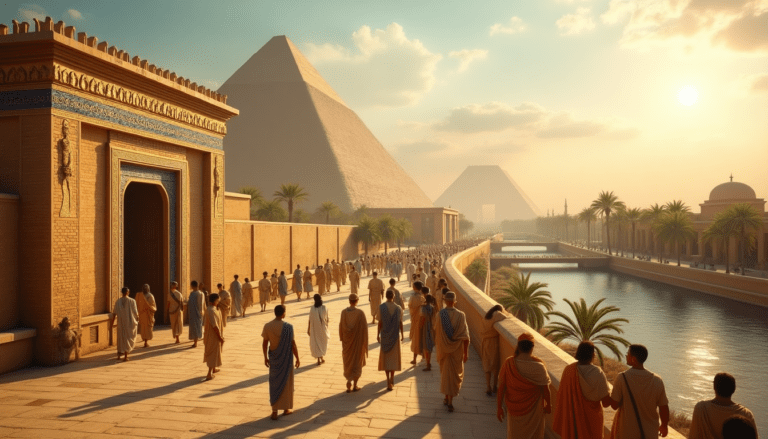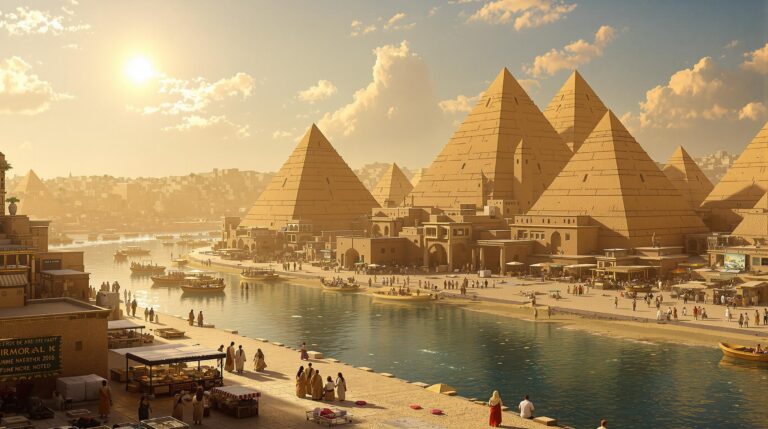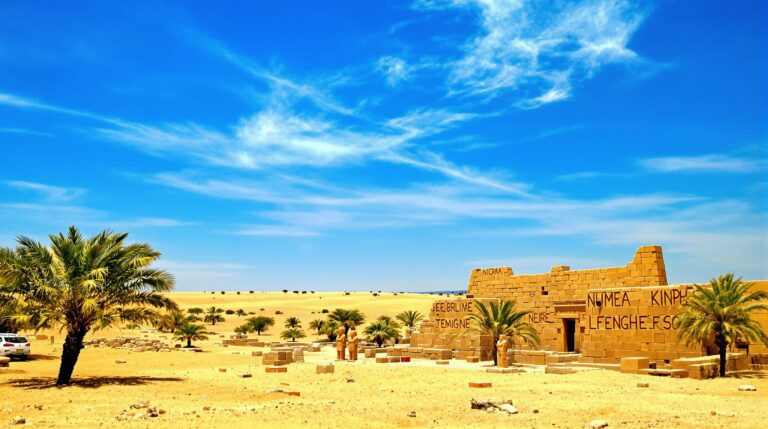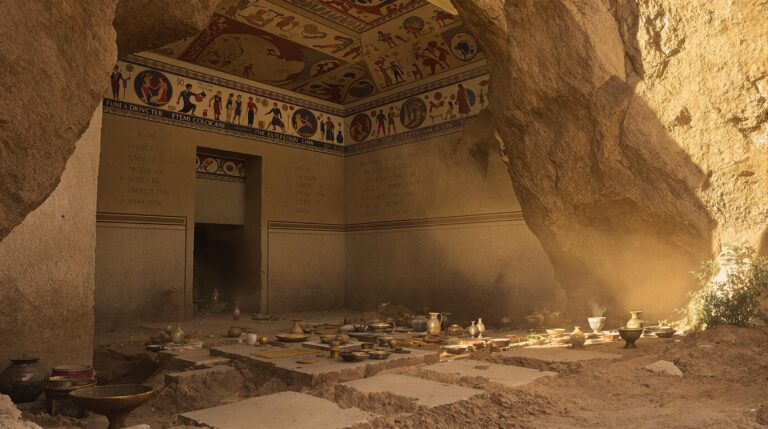Lost Glory of the Nubian Kingdom of Kush
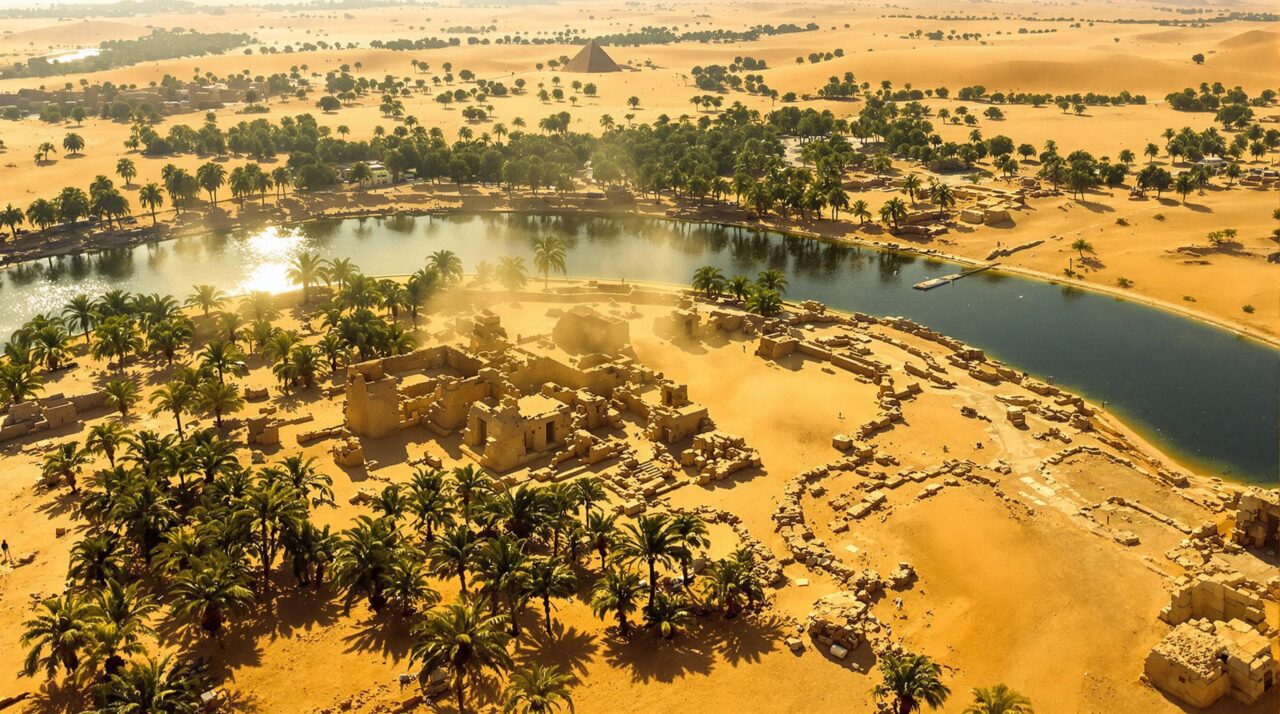
The Kingdom of Kush, often overshadowed by its neighbor Egypt, emerged as a sophisticated civilization with a vibrant mosaic of culture and power.
Nestled along the Nile and the Sahara, it birthed innovations in agriculture and ironworking. Its rulers, especially the formidable Kandakes, wielded influence that shaped their society.
Yet, the whispers of their achievements linger in obscurity. What secrets lie beneath the sands, waiting to be unearthed and understood?
Key Takeaways
Hide- The Kingdom of Kush thrived between the Nile and the Sahara, becoming a key trade hub in ancient Africa.
- Cultural influences from Nubian and Egyptian traditions shaped Kush's unique identity and rich heritage.
- Powerful rulers, including the Kandakes, played significant roles in Kushite politics and society, particularly regarding women's influence.
- Meroë emerged as an ironworking center, revolutionizing the economy and attracting merchants for trade in luxury goods.
- Archaeological discoveries and UNESCO efforts are crucial in preserving the history and legacy of the Kingdom of Kush.
Early Origins of the Kingdom of Kush and Geographic Setting
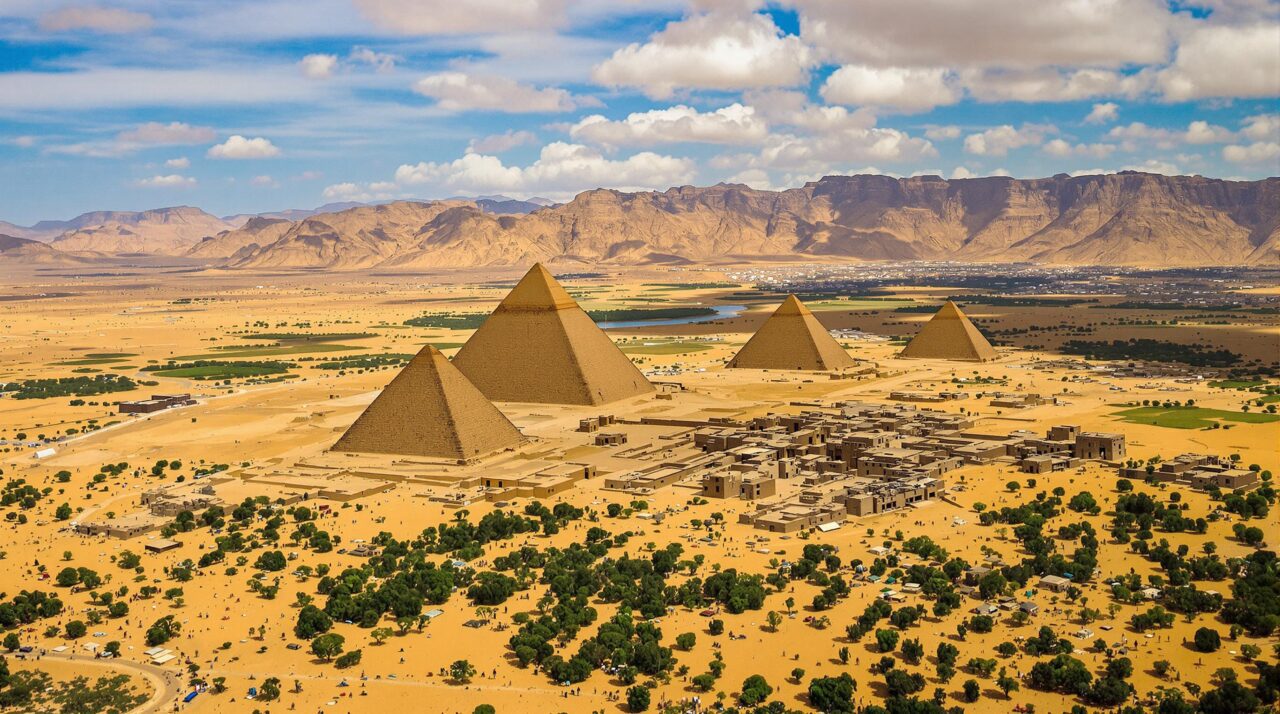
Nestled between the life-giving Nile and the arid expanse of the Sahara, the Kingdom of Kush emerged as a beacon of cultural and strategic significance in ancient history.
Its geographic setting not only facilitated trade and military prowess but also nurtured the rich Nubian foundations that would shape its identity.
From this fertile land, a complex tapestry of traditions and power dynamics began to unfold, heralding the rise of a civilization that would echo through the ages.
The Land of Kush and Its Strategic Location
Nestled between the formidable cataracts of the Nile and the bustling trade routes of Africa, the Kingdom of Kush thrived in a landscape rich with natural resources and fertile soil.
This strategic positioning not only facilitated agricultural abundance but also established Kush as a pivotal nexus for commerce and cultural exchange.
- Sumerian Secrets: The Birthplace of Ancient Innovations
- Göbekli Tepe Mystery: Ancient Site Redefines History
- The Rise and Fall of Carthage: From Empire to Ashes
- Harappan Civilization: Inside the Planned Cities of the Indus Valley
- Etruscan Civilization: Secrets of the Etruscans Uncovered
- Lost Tomb of Cleopatra
As a result, the kingdom’s early origins were marked by a delicate interplay of geography and opportunity, shaping its legacy in the annals of history.
Between the Nile Cataracts and African Trade Routes
The Kingdom of Kush emerged as a lively tapestry woven between the Nile Cataracts and the bustling trade routes of Africa. Its strategic location granted it both prominence and influence in the ancient world.
This confluence fostered a rich exchange of goods and ideas, allowing Kush to thrive as a cultural and economic powerhouse. Its legacy still echoes through the corridors of history.
Natural Resources and Agricultural Potential
Strategically positioned between the fertile banks of the Nile and the arid expanses of the surrounding deserts, the Kingdom of Kush boasted a wealth of natural resources that underpinned its agricultural potential.
Rich alluvial soil, nourished by seasonal floods, enabled lush cultivation. The kingdom’s diverse flora and fauna flourished, providing sustenance and trade opportunities, reflecting the enduring spirit of its people and their connection to the land.
Cultural Beginnings and Nubian Foundations
The Kingdom of Kush emerged as a dynamic tapestry of culture, intricately woven between its distinct Nubian identity and the looming influence of Egypt.
Archaeological discoveries from sites like Kerma reveal a rich heritage, where elaborate burials and artistic expressions speak to a civilization both unique and interconnected.
These findings illuminate the foundational elements of Kushite culture, offering a glimpse into a society that thrived in the shadows of its powerful neighbor while carving out its own narrative in the annals of history.
Distinct from Egypt Yet Deeply Connected
Although the Kingdom of Kush often existed in the shadows of its more renowned neighbor, Egypt, its early foundations reveal a complex tapestry of cultural and geographic influences that shaped its identity.
Situated along the Nile’s southern reaches, Kush flourished with rich resources, lively trade, and unique customs, embodying a distinct essence that both challenged and complemented Egyptian civilization, forging a shared yet independent legacy.
Archaeological Clues from Kerma and Beyond
As the sun rises over the expansive deserts of Nubia, it casts light on the ancient site of Kerma, where archaeological discoveries unravel the early origins of the Kingdom of Kush.
Excavations reveal monumental structures and elaborate burial practices, hinting at a complex society thriving long before recorded history.
These remnants of civilization invite deeper exploration into the intricate fabric of Nubian foundations and cultural beginnings.
Political Power and Royal Lineages

In the shadow of the Nile, the Kingdom of Kush emerged as a formidable power, its royal lineage intricately woven into the fabric of ancient history.
The reign of the Black Pharaohs, a dynasty that transcended borders, marked a stunning chapter where Kushite rulers claimed the throne of Egypt, blending cultures and ambitions.
Here, the regal splendor of golden crowns and majestic pyramids stands as a tribute to a civilization that challenged the might of its neighbors and carved its legacy into the annals of time.
The Rise of the Kushite Kingdom
In the heart of ancient Nubia, the rise of the Kushite Kingdom unfurled with the emergence of powerful centers at Napata and Meroë, each a bastion of political might and cultural richness.
Royal burials, marked by towering pyramids and intricate tombs, whispered tales of divine lineage and the unyielding ambition of its monarchs.
This architectural grandeur not only celebrated their reigns but also solidified the Kushites’ indelible mark on the canvas of history.
Formation of Power Centers at Napata and Meroë
Amid the sun-drenched sands of Nubia, two cities—Napata and Meroë—emerged as formidable power centers that shaped the destiny of the Kingdom of Kush.
Their rise signified a fusion of royal lineage and political ambition, as leaders sought to unify and expand their influence.
- Strategic location along trade routes
- Rich deposits of gold and resources
- Cultural melting pot of traditions
- Architectural marvels symbolizing power
- Dynastic legacies influencing neighboring regions
Royal Burials and Monumental Architecture
While the sun set behind the towering pyramids of Meroë, the grandeur of Kushite royal burials and monumental architecture revealed the kingdom’s profound connection to political power and lineage.
These structures, adorned with intricate carvings, symbolized both divine authority and earthly might, serving as eternal resting places for rulers.
In their shadow, the legacy of a resilient civilization echoed through time, inviting contemplation and admiration.
The Black Pharaohs of Egypt
In the shadowy corridors of ancient history, the 25th Dynasty emerges as a transformative force, where the Black Pharaohs claimed the Nile as their own.
Figures like Piye, Taharqa, and Shabaka not only wielded political power but also crafted a legacy that intertwined the fates of Kush and Egypt, reshaping cultural landscapes.
Their reign stands as a demonstration of resilience and ambition, a narrative woven with the threads of royal lineage and imperial aspiration.
The 25th Dynasty and Their Rule over the Nile
The 25th Dynasty, often referred to as the era of the Black Pharaohs, marked a profound resurgence of power in ancient Egypt, as rulers from the Kingdom of Kush ascended to the throne.
Their reign was characterized by:
- Renewed architectural splendor
- Cultural fusion with Egyptian traditions
- Military campaigns strengthening territorial claims
- Spiritual revival reflecting divine kingship
- Diplomatic ties across the Nile basin
Legacy of Piye, Taharqa, and Shabaka
As the sun set over the banks of the Nile, casting a golden hue upon ancient monuments, the legacy of Piye, Taharqa, and Shabaka emerged as proof of the political acumen and enduring lineage of the Black Pharaohs.
Their reigns blended military prowess with spiritual authority, forging a unique identity that transcended borders, inspiring future generations to embrace the ideals of freedom and cultural pride.
Meroë: A City of Innovation
Meroë, the lively heart of the Kingdom of Kush, thrived as a crucible of innovation, where the art of ironworking transformed both its landscape and economy.
The clanging of hammers and the glow of furnaces painted a picture of industrious ambition, fueling trade and prosperity across the region.
Meanwhile, the emergence of a unique language and script during the Meroitic era reflected a sophisticated culture, bridging the ancient past with the whispers of a literate future.
Ironworking and Economic Development
In the heart of Meroë, the rhythmic clang of iron striking iron echoed through the smelting centers, symbolizing a revolution in craftsmanship that fueled the kingdom’s economic ascent.
As artisans forged tools that shaped both the landscape and trade routes, the city became a lively hub for the exchange of ivory, gold, and exotic goods, attracting merchants from distant lands.
This fusion of innovative ironworking and flourishing commerce transformed Meroë into a beacon of prosperity in the ancient world.
Smelting Centers and Tool Production
Nestled along the banks of the Nile, the ancient city of Meroë emerged as a remarkable hub of innovation, where the art of ironworking transformed both the landscape and the economy of the Kingdom of Kush.
- Advanced smelting techniques
- Durable iron tools
- Economic self-sufficiency
- Skilled labor force
- Cultural exchange through technology
Meroë’s smelting centers epitomized a bold leap into a transformative era.
Trade in Ivory, Gold, and Exotic Goods
The thriving economy of Meroë extended far beyond the boundaries of ironworking, flourishing as a lively trade hub for coveted resources such as ivory, gold, and exotic goods.
Traders from distant lands converged, exchanging colorful textiles and aromatic spices, while the air shimmered with the allure of wealth.
This dynamic marketplace not only enriched Meroë but also wove intricate connections across diverse cultures.
Language and Script of the Meroitic Era
In the shadow of Meroë’s grand temples, the Meroitic alphabet emerged as a colorful tapestry of symbols, weaving together the thoughts and dreams of a civilization rich in culture.
Yet, the script remains an enigma, with scholars grappling with its complexities, unraveling its meanings like threads in a forgotten loom.
This ongoing struggle to fully decipher the language reflects not only the challenges of understanding an ancient society but also the allure of its untold stories.
The Emergence of the Meroitic Alphabet
As the sun dipped below the horizon, casting a warm glow over the ancient city of Meroë, a remarkable transformation was unfolding in the domain of communication.
The emergence of the Meroitic alphabet heralded a new era, enabling the expression of identity, culture, and governance.
- Innovative script development
- Unique phonetic structure
- Cultural significance
- Influence on neighboring regions
- Preservation of history through writing
Ongoing Challenges in Full Decipherment
With the advent of the Meroitic alphabet, the ancient city of Meroë witnessed a flourishing of ideas and communication, yet the path to fully revealing the secrets of this script remains fraught with challenges.
Scholars grapple with incomplete inscriptions and limited bilingual texts, complicating efforts to unearth the nuances of Meroitic thought.
Each discovery inspires hope, yet the script’s mysteries linger, tantalizingly elusive.
Architecture and Iconography
The architecture of the Kingdom of Kush reveals a profound narrative of power and spirituality, embodied in its striking pyramids and majestic temples.
Each structure, adorned with intricate decorative motifs, serves not only as a tribute to engineering prowess but also as a canvas for the rich iconography that speaks to the civilization’s complex beliefs.
As one explores these monumental edifices, the echoes of an ancient society resonate, inviting contemplation of its enduring legacy.
The Pyramids of Kush: Structure and Meaning
The pyramids of Kush rise dramatically from the arid landscape, their pointed silhouettes a symbol of the architectural ingenuity of an ancient civilization.
Each structure, adorned with inscriptions that whisper the sacred beliefs of its time, served not only as royal tombs but as gateways to the afterlife, reflecting the profound connection between the living and the divine.
As one gazes upon these Nubian marvels, the distinctive features—steeper sides and smaller bases—invite contemplation of their unique role in the tapestry of African history.
Distinctive Features of Nubian Pyramids
Although often overshadowed by their Egyptian counterparts, the Nubian pyramids of the Kingdom of Kush emerge as remarkable symbols of a unique architectural vision and cultural identity.
- Steeper angles, showcasing bold engineering
- Smaller base dimensions, creating an intimate scale
- Distinctively adorned with intricate hieroglyphs
- Unique burial chambers, reflecting royal lineage
- Surrounded by sacred temples, connecting life and afterlife
Royal Tombs and Religious Inscriptions
Royal tombs in the Kingdom of Kush stand as profound symbols of the civilization’s reverence for the afterlife and the divine.
Crafted with meticulous precision, these pyramids, adorned with intricate religious inscriptions, served as gateways to eternity.
Each hieroglyph whispers the aspirations of rulers, while the structures themselves embody a celestial harmony, inviting the living to honor the sacred journey beyond mortal existence.
Temples, Palaces, and Decorative Motifs
In the heart of the Kingdom of Kush, temples and palaces rise as monumental symbols of a unique architectural synthesis that marries Egyptian grandeur with indigenous sensibilities.
Intricate reliefs and motifs, laden with symbolic power, adorn these structures, narrating the divine authority of rulers and the cultural narrative of a civilization thriving in the shadows of its northern neighbor.
Each carved detail serves not only as decoration but as a profound statement of identity and legacy, inviting exploration into the vibrant fabric of Kushite artistry.
Blend of Egyptian and Indigenous Designs
As the sun cast its golden rays upon the ancient landscape of the Kingdom of Kush, a remarkable synthesis of Egyptian and indigenous designs emerged in its architecture and iconography.
This fusion created unique structures that celebrated both cultures, revealing a dynamic artistic narrative.
- Majestic pyramids with Nubian flair
- Intricate hieroglyphs blended with local motifs
- Lively temple frescoes capturing daily life
- Ornate palaces showcasing royal power
- Distinctive decorative elements symbolizing unity
Symbols of Power in Art and Relief
Powerful symbols intricately woven into the fabric of Kushite art and architecture reveal the kingdom’s complex relationship with authority and divinity.
Temples adorned with majestic reliefs depict divine figures, while palatial motifs express regal potency.
The interplay of lion imagery and lotus motifs signifies strength and rebirth, inviting viewers to ponder the eternal dance between earthly power and celestial influence, embodying a rich cultural legacy.
Daily Life and Social Structure
In the Kingdom of Kush, daily life was a lively tapestry woven from the threads of agriculture, gender roles, and the influence of royal women.
Fields of golden grain swayed under the sun, while the intricate dynamics of household life revealed the power and responsibilities that women wielded, often overshadowing their male counterparts.
This rich social structure not only shaped the community’s diet but also reflected the deep cultural values that resonated through every aspect of Kushite existence.
Gender Roles and Royal Women
In the enigmatic domain of Kush, the Kandakes—powerful queen mothers—emerged as pivotal figures, wielding influence that shaped both the political landscape and the very structure of daily life.
This matrilineal succession not only elevated royal women to positions of authority but also reframed societal norms, weaving a vibrant fabric where lineage and legacy danced in harmony.
As the Nile whispered through the valleys, so too did the stories of these formidable women, echoing their strength and agency throughout history.
Influence of Kandakes (Queen Mothers)
Throughout the ancient Kingdom of Kush, the influence of the Kandakes, or queen mothers, permeated daily life and social structure, shaping gender roles and the very fabric of society.
Their power was manifested in various ways:
- Guardians of cultural identity
- Political strategists in dynastic matters
- Influencers of religious practices
- Patrons of the arts and architecture
- Symbols of maternal strength and resilience
These roles elevated women’s status within Kushite civilization.
Matrilineal Aspects of Succession
As the sun cast its golden rays across the banks of the Nile, the matrilineal aspects of succession within the Kingdom of Kush revealed a profound intertwining of lineage and power.
Royal women, often wielding authority, shaped dynastic continuity. Their bloodlines dictated inheritance, ensuring that strength and sovereignty flowed through maternal veins, a unique structure that celebrated femininity as a cornerstone of political legitimacy.
Agriculture, Diet, and Domestic Life
In the fertile expanse of the Kingdom of Kush, ingenious irrigation techniques transformed arid landscapes into bustling fields ripe with crops, reflecting a society intricately connected to the rhythms of nature.
The careful tending of livestock and the artistry of pottery not only sustained daily life but also served as lively expressions of cultural identity.
Clothing, adorned with intricate designs, wove together the threads of social hierarchy and artistic expression, painting a vivid tableau of domestic life in this ancient civilization.
Irrigation, Livestock, and Farming Techniques
The lush banks of the Nile, cradling the Kingdom of Kush, served as the lifeblood for its agricultural practices and social structure.
- Ingenious irrigation systems harnessed seasonal floods.
- Diverse livestock included cattle, goats, and sheep.
- Fertile soil yielded grains such as millet and sorghum.
- Cooperative farming strengthened community bonds.
- Sustainable practices guaranteed food security and resilience.
Pottery, Clothing, and Artistic Expression
Life in the Kingdom of Kush flourished not only through its agricultural prowess but also through the lively expressions of its culture embodied in pottery, clothing, and artistry.
Radiant ceramics adorned with intricate designs captured the essence of daily life, while textiles weaved from rich fibers showcased both function and beauty.
Such artistic endeavors reflected the society’s values, aspirations, and a deep connection to their environment.
Spiritual Beliefs and Ritual Practices
In the shadow of towering pyramids, the Kingdom of Kush emerged as a tapestry of lively spiritual beliefs, where gods breathed life into every aspect of existence.
Temples dedicated to deities stood as both sanctuaries and symbols of devotion, while the intricate burial practices reflected a profound reverence for the afterlife, promising an eternal journey beyond the earthly domain.
Here, the interplay of faith and ritual crafted a rich narrative that painted the Kushite experience with both mystery and depth.
Gods of Kush and Their Temples
In the heart of the Kingdom of Kush, the revered gods Amun and Apedemak stood sentinel over a landscape dotted with temples that whispered secrets of ancient rituals.
Local deities, rich in symbolism and deeply intertwined with the daily lives of the people, infused the air with a palpable sense of spirituality.
Sacred rituals and the solemn traditions of priests echoed through the chambers of these sacred sites, painting a vivid tapestry of devotion and cultural identity in a civilization shrouded in mystery.
Amun, Apedemak, and Local Deities
As the sun dipped below the horizon, casting long shadows over the ancient sands of Kush, the spiritual landscape unfolded with a lively tapestry of deities that shaped the lives of its people.
Amun presided over the pantheon, while Apedemak and local gods infused the culture with unique rituals and beliefs.
- Reverence for nature
- Temples as sacred spaces
- Festivals celebrating deities
- Divine protection for the community
- Symbols of power and fertility
Sacred Rituals and Priestly Traditions
While the sun’s rays illuminated the grand temples of Kush, the air was thick with the scents of incense and offerings, enveloping the sacred spaces where priests performed age-old rituals.
These ceremonies, steeped in reverence for deities like Amun and Apedemak, intertwined daily life with the divine, forging a profound connection between the people and their gods, sustaining a lively spiritual legacy.
Burial Practices and Afterlife Views
In the Kingdom of Kush, the solemnity of death transformed into a profound celebration of the afterlife, where mummification served as a sacred bridge between worlds.
Elaborate funerary customs unfolded within intricately designed tomb layouts, each space a tribute to the deceased’s status and beliefs, richly adorned with grave goods meant to accompany them into eternity.
This intricate tapestry of ritual and reverence painted a vivid portrait of a society deeply engaged with the mysteries of existence beyond the grave.
Mummification and Funerary Customs
Mummification and funerary customs in the Kingdom of Kush reveal a profound reverence for the afterlife, reflecting deeply held spiritual beliefs that intertwined the material and spiritual domains.
- Elaborate embalming techniques
- Use of natron for preservation
- Ritualistic ceremonies honoring the dead
- Symbolism in burial attire
- Belief in eternal existence beyond death
These practices illustrate the Kushites’ enduring quest for immortality and spiritual connection.
Grave Goods and Tomb Layouts
Grave goods and tomb layouts in the Kingdom of Kush serve as essential artifacts that illuminate the era’s spiritual beliefs and views on the afterlife.
Elaborate burial chambers, adorned with pottery, jewelry, and tools, reflect a deep reverence for the deceased. Each item, carefully arranged, symbolizes a passage to eternity, revealing the culture’s intricate relationship with death and the hope for an enriched existence beyond.
Relations with Egypt and Other Powers
The Kingdom of Kush, nestled along the banks of the Nile, stood as a formidable player in the intricate tapestry of ancient diplomacy, oscillating between cooperation and conflict with its powerful neighbor, Egypt.
As the sun cast long shadows over the desert sands, Kush’s encounters with the ambitious Romans and the rising kingdom of Axum revealed a landscape shaped by both rivalry and strategic alliances.
Each interaction, rich with the promise of trade and the specter of warfare, painted a complex portrait of a civilization that thrived amidst the ebb and flow of power.
Cooperation and Conflict Along the Nile
Along the meandering banks of the Nile, the Kingdom of Kush thrived in a complex tapestry of trade, warfare, and cultural exchange with its more powerful neighbor, Egypt.
This dynamic interplay not only shaped the political landscape but also left indelible marks on Egyptian religion and art, where Kushite influences whispered through the hieroglyphs and deities.
As alliances formed and rivalries ignited, the river became both a lifeline and a battleground, reflecting the intricate dance of cooperation and conflict that defined their intertwined destinies.
Periods of Trade, War, and Cultural Exchange
Trade routes crisscrossed the arid landscapes of the Kingdom of Kush, weaving a tapestry of interaction that linked this ancient civilization with the mighty Egypt and other regional powers.
These connections fostered a dynamic exchange of ideas, resources, and conflicts, shaping the destinies of nations.
- Flourishing trade in gold and ivory
- Military confrontations with Egypt
- Diplomatic alliances with neighboring states
- Cultural exchanges through art and language
- Shared religious practices and beliefs
Kushite Influence on Egyptian Religion and Art
Interactions between the Kingdom of Kush and Egypt not only shaped political landscapes but also left an indelible mark on religious practices and artistic expression.
Kushite deities, such as Amun, seamlessly mingled with Egyptian pantheons, enriching spiritual life. Meanwhile, exquisite pottery and monumental architecture reflected a fusion of styles, celebrating both cultures.
Consequently, the Nile became a canvas of shared devotion and creativity, transcending borders.
Encounters with Rome and Axum
As the Kingdom of Kush encountered the formidable powers of Rome and Axum, the once-mighty civilization faced a tempest of military resistance and shifting alliances.
Each clash echoed through the valleys, revealing the fragility of Kush’s power as it grappled with external pressures that would lead to its eventual decline.
The intricate dance of diplomacy and warfare painted a stark portrait of a kingdom on the brink, caught between ambition and inevitable collapse.
Military Resistance and Decline
Throughout its storied existence, the Kingdom of Kush engaged in a complex tapestry of military resistance and strategic alliances that ultimately shaped its decline.
The kingdom’s fate interwove with powerful neighbors, forging both conflict and cooperation.
- Persistent skirmishes with Egypt
- Diplomatic ties with Rome
- The rise of Axum’s influence
- Strategic military innovations
- Cultural exchanges that blurred boundaries
This intricate interplay defined Kush’s legacy.
Shifting Alliances and Eventual Collapse
While the Kingdom of Kush once stood as a formidable power in northeastern Africa, its alliances and enmities became increasingly precarious in the face of shifting regional dynamics.
Encounters with Rome and Axum blurred borders, as ambitions clashed. As Egypt’s gaze turned southward, Kush’s internal strife festered, leading to a fragile tapestry of power unraveling, ultimately culminating in its decline and eventual collapse.
Rediscovery and Archaeological Efforts
The Kingdom of Kush, once shrouded in obscurity, has captured the imaginations of European explorers who, in their fervor, often misconstrued its intricate weave of history.
As artifacts emerge from the sands, the challenge of preserving this ancient heritage becomes paramount, revealing layers of cultural significance that demand respect and understanding.
Today, the efforts to illuminate Kush’s legacy stand as a proof of human curiosity and the relentless pursuit of knowledge.
European Explorers and Early Misunderstandings
In the 19th century, European explorers commenced on ambitious expeditions across the arid landscapes of Sudan, their eyes set on the enigmatic Kingdom of Kush, yet often clouded by the shadows of their own misconceptions.
These early adventurers, armed with a mix of curiosity and colonial ambition, laid the groundwork for modern archaeological efforts, though their theories frequently misrepresented the intricate fabric of Kushite history.
As contemporary Sudanese archaeology emerges, it seeks to illuminate the truths obscured by past narratives, revealing the kingdom’s profound legacy beneath the sun-baked earth.
19th-Century Expeditions and Theories
Amidst the shifting sands of time, the 19th century emerged as a pivotal era for the rediscovery of the Kingdom of Kush, a civilization shrouded in enigma and often overlooked by mainstream historical narratives.
- European explorers ventured into uncharted territories.
- Misinterpretations clouded the understanding of Kush’s significance.
- Artifacts revealed rich cultural tapestries.
- Ancient sites sparked fervent debates.
- The quest for knowledge ignited a passion for freedom.
Contributions of Modern Sudanese Archaeology
Though long obscured by the sands of time, the Kingdom of Kush began to reclaim its narrative through the diligent efforts of modern Sudanese archaeology.
Pioneering excavations unearthed forgotten temples and regal tombs, challenging early misconceptions propagated by European explorers.
This resurgence of interest ignited a profound appreciation for Kush’s rich heritage, illuminating its role in the tapestry of ancient civilizations and fostering a newfound cultural pride.
Preserving the Heritage of Kush Today
In the shadow of ancient pyramids, the Kingdom of Kush emerges anew, its heritage safeguarded by UNESCO’s vigilant embrace.
Restoration efforts breathe life into crumbling relics, illuminating the cultural tapestry that binds Sudan and Africa.
As archaeologists sift through time-worn sands, the lively echoes of Kush whisper stories of a civilization that once thrived, urging the world to remember its profound legacy.
UNESCO Sites and Restoration Work
The ancient Kingdom of Kush, shrouded in mystery and splendor, has become a focal point for contemporary archaeological endeavors aimed at unearthing its rich heritage.
- UNESCO World Heritage Sites highlight Kush’s significance
- Ongoing restoration projects revive ancient ruins
- Advanced technologies aid in site preservation
- Collaborative efforts engage local communities
- Educational programs foster global awareness of Kush’s legacy
Cultural Importance for Sudan and Africa
As archaeological teams toil amidst the sun-baked sands of Sudan, the cultural importance of the ancient Kingdom of Kush emerges like a long-buried treasure, revealing its profound impact on both Sudanese identity and the broader African narrative.
Rediscovering Kush’s rich heritage fosters a sense of pride, bridging past and present while inspiring contemporary movements that seek to reclaim African history and celebrate its diversity.
Wrapping Up
The Kingdom of Kush, shrouded in the mists of time, emerges as a lively tapestry woven with ambition, innovation, and spirituality.
Its towering pyramids and bustling cities echo the whispers of an era where powerful Kandakes ruled with wisdom, guiding their people through the shifting sands of history.
As modern archaeologists wield their metaphorical GPS, they unearth the forgotten narratives of this ancient civilization, ensuring that the legacy of Kush continues to inspire generations yet to come.

